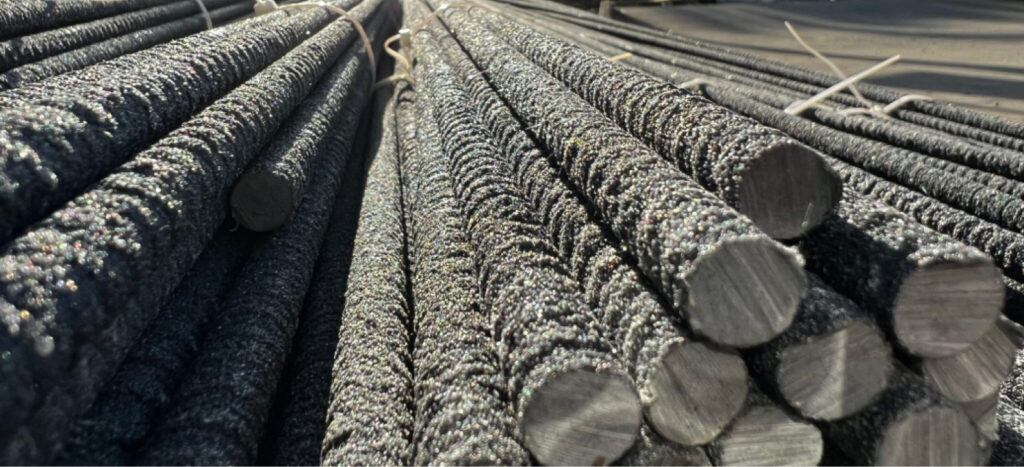Editor’s Note: This post, originally published on June 25, 2020, has been thoroughly revised and updated to ensure accuracy and comprehensiveness.
Is your construction project prepared for the future? Innovation is the key to sustainability and longevity in the ever-evolving construction world. One such innovation making waves in the industry is Glass Fibre Reinforced Polymer (GFRP). GFRP might cost slightly more than the usual steel reinforcement because of the differences in the manufacture and use of the two types of reinforcement, GFRP has numerous advantages that make it a worthwhile investment in the long run.
What is GFRP?
Glass Fibre Reinforced Polymer (GFRP) is a composite material from high-strength glass fibres embedded in a polymer matrix. This innovative material is designed to replace traditional steel reinforcement in concrete structures. GFRP offers several advantages, including exceptional corrosion resistance, high tensile strength, and lightweight properties. Its unique material will last longer durability and reduced maintenance costs, making it an ideal choice for modern construction projects.
Why Choose GFRP?
- Corrosion Resistance: Unlike steel, GFRP does not corrode. This corrosion resistance eliminates the swelling that leads to cracks and spalling in concrete, ensuring the structural integrity of buildings and infrastructure for up to 200 years. This translates into significant savings on maintenance and repair costs.
- Lightweight and Durable: GFRP is significantly lighter than steel, weighing between one-quarter and one-seventh of traditional steel reinforcement. This lightweight nature reduces labour and installation costs, minimises the risk of injuries during handling, and prevents damage to the reinforcement material itself.
- Sustainability: At Danterr, we prioritise sustainability in all our operations. GFRP is a testament to this commitment. Its long lifespan and durability reduce the need for frequent replacements, thus conserving resources and reducing waste.
Market Growth and Applications
The global GFRP market is booming, currently valued at over half a billion USD annually and growing at a rate of approximately 8% per year. This growth is driven by rapid infrastructure development and increased construction spending worldwide.
- Infrastructure Projects: In Australia, GFRP has become increasingly popular in light rail projects due to their non-conductive properties which make it more appropriate for use in places where steel conductivity is considered a hindrance.
- Marine Structures: GFRP’s resistance to alkali and chlorine makes it an excellent choice for marine structures such as jetties, wharves, and seawalls. Its durability in harsh marine environments ensures long-lasting performance without the need for frequent repairs.
- Medical Facilities: In hospital settings, particularly in rooms with sensitive equipment like MRI machines, GFRP is preferred over steel due to its non-conductive nature, ensuring no interference with medical equipment.
Enter your email to explore our top-quality construction solutions. We’re here to support your project’s needs with innovative, sustainable products.
Catalogue Form
Projects Using Danterr’s Fibreglass (GFRP) Products
- Sydney Gateway Project: Utilized GFRP for reinforcement to improve traffic flow and reduce maintenance costs.
- Mona Vale Road East Upgrade: Employed GFRP to enhance safety and traffic flow, leveraging its lightweight and durable properties.
- Sydney Light Rail: Implemented GFRP for non-conductive reinforcement, ensuring safe and efficient public transport.
- Tolosa Water Supply Upgrade Project: Used GFRP to reinforce water structures, benefiting from its corrosion-resistant properties.
- Musselroe Wind Farm: Integrated GFRP for sustainable and long-lasting wind farm infrastructure.
- INPEX Project, Darwin: Applied GFRP for durable and maintenance-free reinforcement in harsh environments.
- Sydney Metro Northwest NRT Project: Adopted GFRP for its non-conductive and lightweight benefits, improving overall project efficiency.
- Hornsdale Wind Farm Project: Utilized GFRP to reinforce wind farm structures, ensuring durability and sustainability.
Economic and Environmental Benefits
- Cost-Effectiveness: While the initial cost of GFRP may be higher than steel, its long-term benefits outweigh the initial investment. Less maintenance requires less money, cheaper transportation due to its relatively lightweight nature, and fewer repairs make GFRP more economical in the long run.
- Environmental Impact: The use of GFRP aligns with the global shift towards sustainable construction practices. It offers the advantages of a less demanding production and its use has a shorter ecological footprint than regular materials. As we face increasing challenges from climate change, adopting materials like GFRP helps mitigate our environmental footprint.
The future of construction hinges on innovative and sustainable materials like GFRP. Its benefits are clear: enhanced durability, cost savings, and a significant reduction in environmental impact. As construction professionals, it’s our responsibility to explore and integrate these advanced materials into our projects to build a more resilient and sustainable infrastructure.
Conclusion
At Danterr, we are committed to providing top-quality, innovative construction solutions. Glass Fibre Reinforced Polymer is a prime example of how we can achieve this. By embracing GFRP, we are not just building for today but also for a sustainable future. Contact Danterr today!
📞: 1800 262 383
📧: sales@danterr.com
Frequently Asked Questions:
Glass Fibre Reinforced Polymer (GFRP) is a composite material composed of high-strength glass fibres within a polymer matrix. It is engineered to replace traditional steel reinforcement in concrete structures due to its superior properties like corrosion resistance, high tensile strength, and lightweight nature. GFRP is particularly advantageous for long-term structural integrity and reduced maintenance costs, making it ideal for various modern construction applications.
GFRP offers several advantages over steel, including:
- Corrosion Resistance: GFRP does not rust, which enhances the longevity of structures.
- Lightweight: It is significantly lighter, which reduces transportation and handling costs.
- High Strength: GFRP has excellent tensile strength, often exceeding that of steel.
- Non-Conductive: Ideal for applications where the electrical conductivity of steel is a concern.
- Durability: GFRP has a longer lifespan, reducing the need for frequent repairs and maintenance.
Initially, GFRP can be more expensive than steel. However, considering the long-term benefits such as reduced maintenance, lower transportation costs, and extended lifespan, GFRP becomes more cost-effective over the life cycle of a project. The initial investment in GFRP pays off through decreased repair costs and improved structural integrity over time.
GFRP is versatile and can be used in a variety of applications, including:
- Infrastructure Projects: Bridges, highways, tunnels, and buildings.
- Marine Structures: Jetties, wharves, seawalls, and other structures exposed to harsh marine environments.
- Medical Facilities: MRI rooms and other areas requiring non-conductive materials.
- Residential and Commercial Buildings: For areas prone to moisture and corrosion.
- Public Transport Projects: Light rail and metro systems.
No, GFRP is a non-conductive material. This makes it an excellent choice for applications where the electrical conductivity of steel could pose a problem. For instance, in light rail projects or medical facilities like MRI rooms, GFRP’s non-conductive nature prevents interference with electrical systems and sensitive equipment.
GFRP is commonly used in various infrastructure applications due to its durability and corrosion resistance:
- Bridges: To enhance lifespan and reduce maintenance costs.
- Highways: For reinforcement in road construction.
- Tunnels: To provide long-lasting support structures.
- Buildings: In concrete reinforcement for improved structural integrity.
- Public Transport Systems: Such as light rail and metro lines, where non-conductivity is crucial.
Yes, GFRP is suitable for residential construction, particularly in areas prone to moisture and corrosion. Its benefits, such as corrosion resistance, lightweight, and high strength, make it an excellent alternative to steel reinforcement in residential buildings. GFRP ensures long-term durability and reduces the need for frequent maintenance.
GFRP can last up to 200 years without significant degradation. This exceptional lifespan far exceeds that of traditional steel reinforcement, making GFRP a superior choice for long-term construction projects. Its durability ensures that structures reinforced with GFRP remain robust and maintenance-free for decades.
GFRP is highly resistant to damage from freeze-thaw cycles. Unlike steel, which can suffer from corrosion and cracking due to freeze-thaw expansion, GFRP maintains its integrity and strength. This makes it an ideal material for use in climates with significant temperature fluctuations, ensuring the long-term durability of structures.
Yes, GFRP is recyclable, which contributes to sustainable building practices. Recycling GFRP reduces waste and conserves resources, aligning with global efforts to promote environmentally friendly construction methods. Its recyclability further enhances its appeal as a sustainable alternative to traditional materials.
GFRP can be installed using conventional construction methods, making it easy to integrate into existing projects. Its lightweight properties simplify handling and installation, reducing labour costs and the risk of injury. GFRP’s flexibility allows it to
Stay Updated with Danterr!
Subscribe to Our Newsletter for the Latest in Construction Solutions


